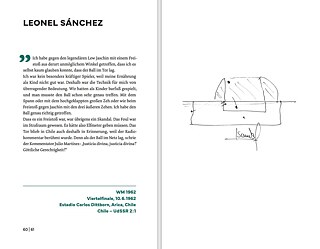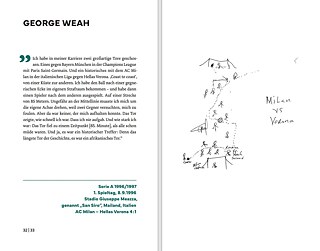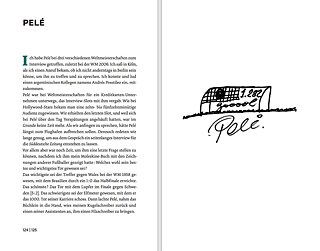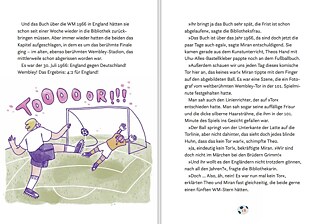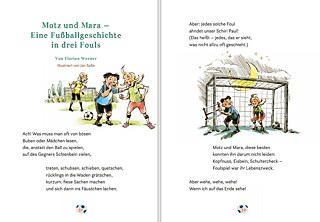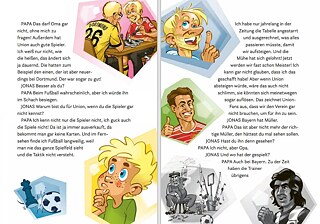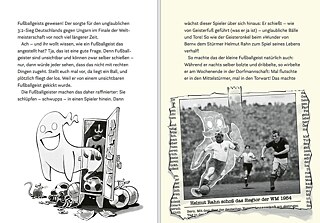Cherrypicker | Literature
And the ball rolls forever

The European Football Championship has just kicked off in Germany. Just in time, we present a small, well-rounded selection of football books – including painted goals and literary texts.
By Holger Moos
Can you draw goals? Is football art after all? Javier Cáceres, sports editor at the Süddeutsche Zeitung, asks this and more in his new book Tore wie gemalt (Goals as if painted). The book was the result of a coincidence: Cáceres met the national football hero Leonel Sánchez (1936-2022) in Chile in 2005 – and he described a goal to him. As the reporter didn't understand how it had been scored, he simply handed Sánchez his notebook and asked him to draw how the goal had been scored. Cáceres liked the result. He pursued the idea further, so that his notebook filled up with more and more drawings that literally realised the reporter's phrase "ein Tor wie gemalt" ("a goal as if painted"). From Franz Beckenbauer, Günter Netzer, Gary Lineker to Pelé, from Mario Götze, Xabi Alonso to Kai Havertz: more than 100 stars scribbled their most important goals on a sheet of paper. In a short text at the beginning of the book, they explain why they chose each goal: "Each drawing is an opportunity to remember, discuss or even replay one or two goals."
Although you can see from the drawings why it was better that the performers did not pursue any artistic goals and hopefully were not called to the tactics board too often, the anecdotes about the goals are worth reading and offer some surprises. The Chilean Elías Figueroa, for example, not only had to lay hands on the sick as a result of a goal that went down in history as the "illuminated goal", but also "stroked many pregnant bellies". And Liberian striker George Weah explains why "the longest goal in history ... was an African goal". The comments on the goals vary. In the case of Oliver Bierhoff, one or two communication training sessions may be responsible for the fact that his text is by far the longest. Former HSV professional Jimmy Hartwig, on the other hand, focussed on the essentials:
HSV - Bayern Munich. Corner. Here stood one, here stood one, here stood one, here stood one. Jimmy was standing here. Everything was covered. The ball came in nicely. I lift it over this one player - and hit it into the corner. You have to watch it on YouTube!
Past glory
Renowned sports journalist and author Ronald Reng takes a look back. His books such as Robert Enke. Ein allzu kurzes Leben (2010), Spieltage. Die andere Geschichte der Bundesliga (2013) and Mroskos Talente (2016) have received numerous awards. With his new football book 1974 – Eine deutsche Begegnung (1974 - A German Encounter), he has created "a vivid portrait of divided Germany in the 1970s" based on the legendary World Cup preliminary round match between the Federal Republic and the GDR, in which the GDR team famously defeated the eventual world champions 1:0, according to Hendrik Nolde in his article in our current European Championship special.Sports journalist and blogger Tobias Escher, who co-founded the football tactics blog spielverlagerung.de in 2011 and now works full-time as a freelance journalist, including for the daily newspaper Die Welt and the football magazine 11 Freunde, looks back as far as 1954, another twenty years. In his book Die Weltmeister von Bern (The world champions of Bern), he has written a "biography of a team of the century". The German World Cup victory in 1954 is still regarded today as the "Miracle of Bern". However, Escher is not only concerned with the events surrounding that World Cup, he also tells the story of what happened afterwards. He traces the often not at all glamourous lives of various players and coach Sepp Herberger. "The fact that Tobias Escher's book is not one of many is thanks to his precise, empathetic portrayal of the footballers and their lives, but also to his always critical spirit. A book that is more than worth reading – and not just for football fans", according to the review on Sachbuch-Couch.de.
A look behind the scenes
The special editions of the football magazines Kicker and 11 Freunde provide good overviews and insights into the current tournament and the individual national teams. Dieter Hintermeier takes a comprehensive look at the economic aspect of the events surrounding the game in Wirtschaftsmacht Fußball (Football as an economic power). In addition to the players, coaches, managers and fans, he covers topics as diverse as football and politics, the history of the Bundesliga, global investors, women's football, the role of the media and artificial intelligence.New football books have also been published for the little ones. Parents can read aloud the book Tor! (Goal!) published by author Moritz Rinke. The 13 illustrated stories come from the captain of the German national team İlkay Gündoğan, the professional footballer Lina Maguli, the national team of authors and others and are very different. There are descriptions of formative experiences such as that of Lina Maguli, who with the youth team of her neighbourhood club – she was the only girl on the pitch – defeated the D-youth team of the overpowering Borussia from Dortmund by scoring a hat trick. Moritz Rinke contributes a fantastic story involving fairy dust in the school library. In it, two children even manage to undo the famous Wembley goal from the 1966 World Cup final – even if it was to no avail. England still won against Germany, but only 3:2.
Cantona and the stoned postman
The writer Albert Ostermaier has published his football texts from the last 10 years in Rote Asche (Red Ashes). These are poems, most of which were written during the last World Cups and European Championships, and three theatre texts dedicated to the Hungarian football player and coach Jenő Konrád (1894-1978), the Italian film director and poet Pier Paolo Pasolini (1922-1975) and the Northern Irish striker George Best (1946-2005), who was known for his extravagant lifestyle. At the end of the book there is an ode to the French striker Eric Cantona, who was considered an enfant terrible and untrainable during his playing days and later tried his hand at acting. His appearance in Ken Loach's tragicomedy Looking for Eric (2009), when he appears as a ghostly mentor to the stoned main character, a depressed postman, is unforgettable. Ostermaier presents Cantona as a symbol of the resistant and unyielding:"the place that meant
the world to him is now
under his feet
when he stands on the stage
and says into the eye
he is not human
I am cantona and where
I am the world is out
out of joint because never
I will submit
but always love
what and who I love"
If you can't get enough of football, you should definitely read Thomas Brussig's referee and coach monologues in Mats Hummels auf Parship (Mats Hummels on Parship) and Frank Goosen's charming and enjoyable football novel Spiel ab! (Play ball!). You can find out more about both books here.
Berlin: Insel, 2024. 317 p.
ISBN: 978-3-458-64444-6
You can find this title in our eLibrary Onleihe.
Tobias Escher: Die Weltmeister von Bern. Biografie einer Jahrhundertmannschaft
Hamburg: Rowohlt, 2024. 432 p.
ISBN: 978-3-499-01442-0
You can find this title in our eLibrary Onleihe.
Dieter Hintermeier: Wirtschaftsmacht Fußball. Hintergründe, Fakten und Visionen eines globalen Milliardengeschäfts
München: Hanser, 2024. 264 p.
You can find this title in our eLibrary Onleihe.
Albert Ostermaier: Rote Asche. Fußball-Texte 2014-2024
Wien: Korrektur Verlag, 2024. 266 p.
ISBN: 978-3-9505470-4-7
Ronald Reng: 1974 – Eine deutsche Begegnung. Als die Geschichte Ost und West zusammenbrachte
München: Piper, 2024. 432 p.
ISBN: 978-3-492-07219-9
Tor! Das Fußballbuch von Profis zum Vorlesen (herausgegeben von Moritz Rinke)
Hamburg: Carlsen, 2024. 119 p.
ISBN: 978-3-551-52278-8
